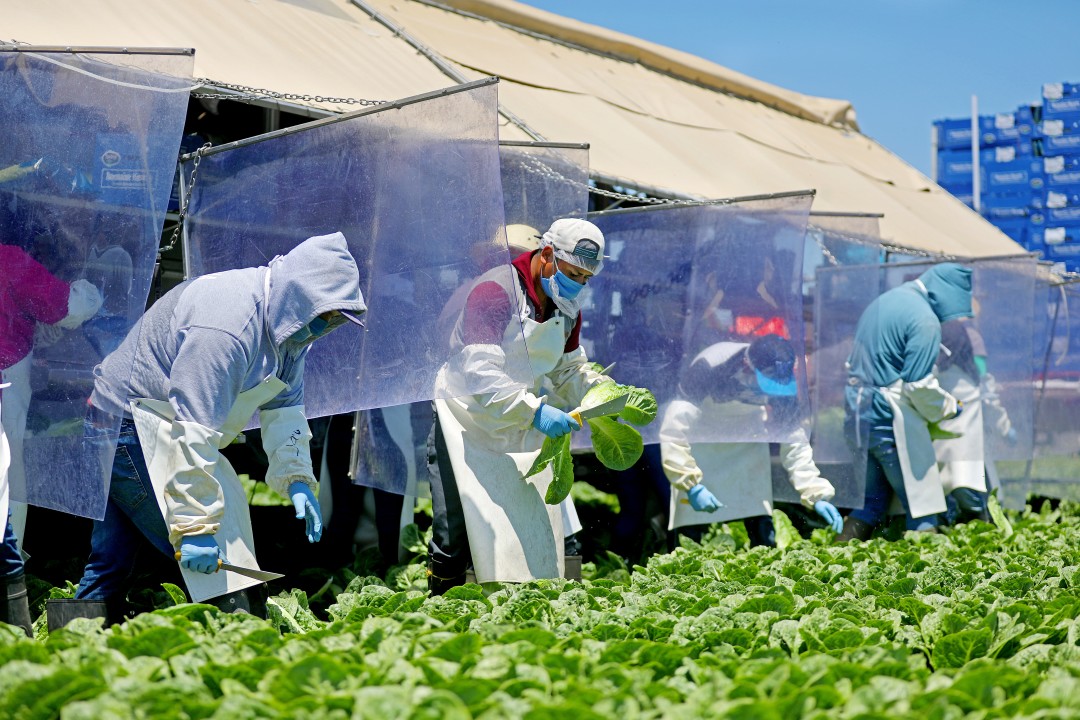 Bert Corona, father of the modern immigrant rights movement, whose accomplishments were compared with those of Cesar Chavez.
Bert Corona, father of the modern immigrant rights movement, whose accomplishments were compared with those of Cesar Chavez.
Photo from 1997.(Lori Shepler / Los Angeles Times)
by David Bacon
On June 24, new COVID-19 cases passed 200 in one day in rural Yakima County in central Washington state for the third time this June. That brought the total number of people infected to 6,940, and the number of the dead to 132. The infection toll for Seattle’s King County, with a population ten times larger than Yakima’s, was 9,453.
COVID numbers are spiking in farmworker communities all over the United States. On June 26, the Imperial Valley, on the California-Mexican border, the source of winter vegetables worth over $1.8 billion per year, registered 5,549 cases and 70 deaths. In California’s huge San Joaquin Valley, Fresno County had 3,892 infections and 71 deaths, and Kern County had 4,108 cases and 63 deaths. Collier County in Florida, center of the U.S. tomato crop and headquarters of the Coalition of Immokalee Workers, had 3,778 cases and 70 deaths. Cumberland County, New Jersey’s agricultural heartland, had 2,876 cases and 124 deaths, and nearby Chester County, Pennsylvania, where workers labor in Kennett Square’s mushroom sheds, had 3,437 cases and 313 deaths. In Arizona’s Yuma County, an irrigated desert along the Colorado River, there were 5,323 cases and 76 deaths.
This raging rural infection rate, which tracks those of urban counties many times their size, is not due to a refusal by farmworkers to wear facemasks. It is a function of structural racism-the way immigrants in general, and farmworkers in particular, are treated as disposable labor. People in the fields are viewed as machines, whose ability to work is the only aspect of their human value worth considering.
There is no clearer demonstration of this fact than the immigration order issued by the Trump administration on June 23. President Trump boasted that he would «preserve jobs for American citizens» by stopping the recruitment of guest workers in four visa categories. He failed to mention, however, that he was leaving untouched the country’s main guest worker program, under which growers bring farm laborers to the U.S.-the H-2A visa program.
Faced with the need to please agribusiness, Trump made clear that no rhetoric about family values applies to farmworkers. H-2A migrants cannot bring a wife or a child with them (the program notoriously discriminates against hiring women), so they live the lives of lonely men in barracks. And in its most significant impact on families, Trump’s order would close down the country’s historic path for keeping families together-the family preference system for granting residence visas, or «green cards.»
Smoke and Mirrors
There’s nothing new about streamlining the labor supply for growers, making it cheaper and more vulnerable, under the cover of anti-immigrant rhetoric.
Trump’s order ostensibly stops the issuance of visas for four much smaller guest worker programs, including H-1B for workers in health care and high tech; H-2B for non-agricultural workers, mostly in landscaping, forestry, and food processing; L-1 for corporate executives; and J-1, the visa for students in cultural exchange programs, au pairs, and university researchers.
Nativist anti-immigrant organizations duly praised the order, which a senior administration official claimed to Vox «would open up 525,000 jobs.» The anti-immigrant Center for Immigration Studies declared, «Now there is a new sheriff in town. For the first time, a president has stood up for the American people.» According to Tom Homan, former acting director of Immigration and Customs Enforcement under Trump, «With record unemployment crushing millions of Americans … importing more foreign labor … is simply unacceptable.»
Almost all media coverage took Trump’s claim at face value. Yet the announcement was clearly a case of smoke and mirrors. According to Mary Bauer, counsel for the Centro de los Derechos de Migrantes (the Center for Migrant Rights), «We can’t figure out where these numbers are coming from. This administration just makes things up.»
In March, Trump shut down the international division of Citizenship and Immigration Services, the office that processes all visa applications abroad, and effectively closed visa operations at U.S. consulates. Most H-1B and H-2B work visa applications for this year had already been made and approved, however, and will be unaffected by the new order. The impact on employers, therefore, will be small, despite their loud, pro-forma protests.
In any case, those two visa categories have caps of 65,000 each, making them much smaller than the untouched guest worker program for agribusiness, which has no cap. Last year the administration certified grower applications to fill over a quarter of a million jobs with H-2A workers. And when Trump in March shut down the processing of all other visa applications, growers got the administration to keep their flow of guest workers going.
Adding one more wrinkle, the order allows employers to apply for exceptions to the work visa bans. A blanket exemption has already been made for the food supply and health care industries. Meatpacking companies that use H-2B visas to send workers into COVID-saturated plants will undoubtedly win exemptions, as will hospital corporations that want H-1B nurses to risk their lives in the pandemic’s emergency rooms. «But where’s the protection from OSHA, or for wages and sick pay, or any reform of the abuses of these guest worker programs?» Bauer asks. «There’s nothing here to protect workers, regardless of whether they’re guest worker visa holders or citizens.»
Resisting the Impact of the Virus
That lack of protection is especially serious for the huge wave of workers recruited by agribusiness. Bringing H-2A workers into the country in the middle of a pandemic is dangerous. Mexico, the country from which over 250,000 were recruited last year, is struggling to contain its own outbreak. There is no testing for these contract workers as they cross the border. Meanwhile, in the U.S. towns where they’re put to work, COVID cases are spiking.
COVID infections go back and forth between workers themselves and their surrounding communities. In March and April, the biggest apple grower in Washington, Stemilt Fruit, admitted that over 50 workers it had recruited in Mexico had the virus. Because these workers showed symptoms more than one month after their arrival, it was likely they hadn’t brought the illness with them-they were infected here.
In many places, non-H-2A farmworkers and their families have gone on strike to enforce working conditions that would keep the virus from spreading.

On the same day that virus cases reached 3,533 in California’s Tulare County, with 118 deaths, sorters went on strike in the sheds of Primex Corporation’s 5,000 acres of pistachio groves. Although workers say 61 have tested positive, one worker, Veronica Perez, says the company was selling them facemasks for $8 apiece. Another worker, Ernestina Mejia, charged, «The company told us nothing. We found out workers were getting sick by talking with each other in the bathroom. Now my whole family is infected.»
Workers in Yakima Valley apple packinghouses went on strike earlier this month for the same demand-safety from the virus. Knowing the disease was peaking in their county, they wanted hazard pay to compensate for the terrible risk involved in just going to work.
Raising wages, however, is not part of the administration’s plan. Instead, Trump has promised to help growers lower the required pay for H-2A workers, who now make up 10 percent of the U.S. farm workforce. Currently, each state has to calculate an Adverse Effect Wage Rate that won’t undermine the wages of farmworkers already living here, who are mostly immigrants themselves. The new rule that the administration is proposing would cost workers up to $6 an hour, while saving growers millions.
Lowering wages for H-2A workers would pull the floor from under farmworker wages in general. In Georgia, growers already fill a quarter of all farm labor jobs with H-2A visa holders. Local farmworkers are not in a strong position to insist on higher wages in the face of this forced competition. The income of farmworkers nationally is already below the poverty line, with an average annual family income between $17,500 and $20,000.
Grower pressure to lower costs, even at the risk of the spread of the virus, descends on states as well. In Washington, a state with a Democratic governor and legislature, the department of health was pressured to issue a toothless «guideline» for grower housing that puts workers’ lives at risk. In the barracks for H-2A migrants, workers sleep in bunk beds closer to each other than the six-foot distance recommended by the state’s own epidemiologists. Prohibiting bunk beds, however, would have required growers to build additional housing or hire local workers instead. Either alternative would increase costs. The «guidelines» therefore gave bunk beds the stamp of approval, and farmworker unions and advocates are now suing the state’s Democratic administration.
Undoing What the Civil Rights Era Won
Unsurprisingly, Trump has repeatedly declared his support for the agricultural guest worker program. In a 2018 Michigan speech he told a grower audience, «We’re going to let your guest workers come in, because we have to have strong borders, but we have to let your workers in … We have to have them.»
Agriculture Secretary Sonny Perdue has explained that the administration wants «to separate immigration, which is people wanting to become citizens, [from] a temporary, legal guest-worker program. That’s what agriculture needs, and that’s what we want.»
There’s nothing new about streamlining the labor supply for growers, making it cheaper and more vulnerable, under the cover of anti-immigrant rhetoric. Growers’ desire for low-wage labor was the justification for the bracero program, which brought up to half a million people per year from Mexico, to harvest U.S. crops between 1942 and 1964. The program was notorious. Braceros were held in labor camps, often behind barbed wire. If they went on strike, they were deported. If local workers went on strike, growers brought in braceros to replace them.

Deportations and anti-immigrant racism were part of the scheme. In one year, 1954, the U.S. deported 1.1 million migrants in «Operation Wetback.» Two years later 445,197 braceros were brought to work on U.S. farms, 153,000 in California alone.
People who came as braceros did try to stay in the U.S., even if it meant walking away from those labor camps and living without documents for years. But bringing family members and setting down roots was out of the question – for both braceros and the undocumented. During those Cold War years it was very difficult for immigrants to come to the U.S. legally from Latin America, the Philippines and other non-European countries.
The growing Chicano civil rights movement of the early 1960s, led by Ernesto Galarza, Bert Corona, Cesar Chavez and others, sought to overturn turn this racist system, which prioritized growers’ labor needs over the needs of workers and families. In 1964 their organizing efforts grew strong enough to force Congress to repeal Public Law 78 and end the bracero program.
The following year, the Immigration and Nationality Act of 1965 set up a system in which people from all nations-not just Western Europe-could come to the U.S., and in which those already in the U.S. could petition for visas for mothers, fathers, daughters, sons, brothers, and sisters. Community demographics changed in the wave of immigration that followed. Migrant workers still followed jobs and crops, and slept in labor camps. But at the same time immigrant families-mostly people of color-sought to reunite themselves and set down roots. Their communities grew, and together with the civil rights and labor movements, began to challenge local rightwing regimes. In time, Los Angeles was no longer governed by the racist Sam Yorty, and slowly, California-once the political home of Richard Nixon and Ronald Reagan-became a «sanctuary» state.
Today Latinxs and Asian Americans join Black youth, supported by young white people, in the huge street protests over the police murders of George Floyd, Breonna Taylor and Andy Lopez. The growth and radicalization of immigrant communities helped make this alliance possible.
Failing to See the Danger
At the federal level, however, many «immigration reform» proposals, including laws passed in the 1980s and 1990s, have sought to reverse this course by establishing new bracero-type programs, criminalizing immigration and militarizing the border. The family preference system has been sabotaged by limits on the available visas. The waiting time for a visa to bring a married son or daughter from Manila or Mexico City is now over 22 years.
Trump’s new order makes this course reversal official, at least until it expires in December, by placing no limits on guest workers for growers, and completely ending the issuance of visas for family reunification. That is basically the return of the U.S. immigration policy of the 1950s.
That prospect should make the order an election issue. To be sure, ending the family preference system permanently, in the view of the CDM’s Mary Bauer, cannot be accomplished without an act of Congress, rewriting the 1965 law. «Trump has been able to use the pandemic to impose temporary measures, but permanent changes can’t be done by executive order,» she says.
Nevertheless, should Trump win reelection, it is clear that he would try to extend his order and make it permanent. A Supreme Court majority that upheld the DACA program only a week after giving its blessing to the administration’s restrictions on asylum applicants cannot be depended on to save family preferences.
Why, then, is this not a big issue for Democrats? Some Democratic office holders buy the neoliberal idea that immigration policy should be «market based» and serve labor needs. There was significant support in the party for those parts of past comprehensive immigration bills that sought to end some family preferences, using the argument that they weren’t serving the needs of the economy.
At the same time mainstream Democrats supported other proposals to tie the qualifications for receiving visas to employable skills and higher education – requirements favored by employers (and Trump) but that would erode, and eventually end, the family preference system. Some, like California’s Sen. Diane Feinstein, support H-2A and guest worker programs and see no problem making alliances with growers to preserve them.
But what about the Democratic left? A class perspective no longer gets a candidate redbaited when it’s applied to issues like health care, gentrification, or fighting the banks. But that perspective is strangely absent when it comes to much of U.S. immigration policy.
Part of the problem is historical amnesia. We don’t remember the fights it took to get what we have now. We may remember names like Cesar Chavez, Ernesto Galarza, and Bert Corona, but we don’t quite remember what it was they fought for, or why.
Amnesia can be costly, though. At a minimum it will keep the Democratic Party from campaigning on an issue the Trump administration has handed to it. And should the election go awry, it would mean a fast track backwards to one of the most abusive periods for immigrants in U.S. history. If the Democrats win, defending family preferences and ending the H-2A program isn’t a given either, but fighting for those goals now will build a more powerful movement for them if a new administration takes office.
As COVID-19 sweeps through rural counties and farmworker towns, Trump’s immigration order may seem a distant issue. But the administration is using the pandemic to accomplish a goal it might not be able to otherwise, moving while attention is focused on immediate illness and death. To fight the virus’s spread, workers and immigrants have to challenge not just the dangerous working and wretched housing conditions but also the entire system of immigration and guest worker policies from which they arise. They have to fight for the same goals that Galarza and Corona fought for more than half a century ago.
«Trump is dismantling all protections for immigrant communities, especially for families and workers,» says Alma Maquitico, co-director of the National Network for Immigrant and Refugee Rights. «Our families are the ones risking COVID to harvest crops and care for others. We need real legalization for those without papers, and a working preference system for keeping our families together. Guest worker programs don’t do either of these things. They just exploit us.»
Entre Noticias | Reality Check | evr







